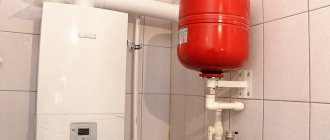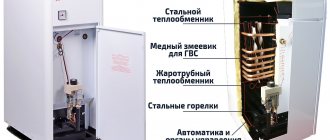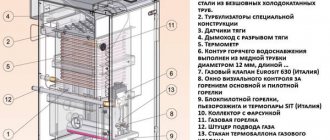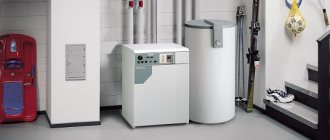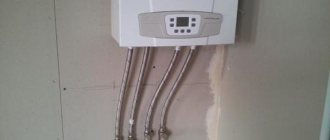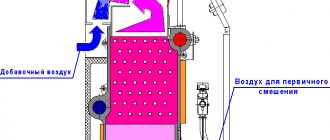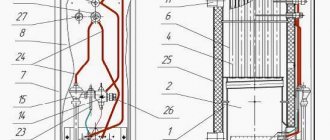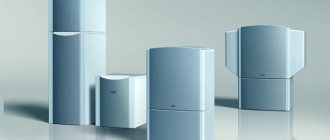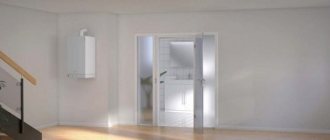For heating equipment installed in private homes, almost all known types of fuel are used - wood, peat, coal, electricity, natural gas. In our country, with its resources, gas equipment has become one of the most popular. It is distinguished by a fairly low price and relative availability. The designs of boilers that are used to heat houses are easy to operate and safe to operate, but, of course, subject to a number of rules.
Operating principle of the boiler
Heaters operating on gas fuel may differ from each other in design and technical characteristics, they all use the same principle - heating the working environment of the heating system using burning fuel, in our case natural gas.
Gas is used not only for space heating, but also for heating water. For this purpose, either water columns or double-circuit boilers are used. The equipment used these days is equipped with highly effective safety systems - they keep the gas combustion process under control. But, nevertheless, there are mandatory rules for the use of gas equipment and compliance with them can become a guarantee of safety.
Before putting the equipment into operation, the user must ensure:
- There is the required amount of working fluid in the heating system.
- The fact that the burner and safety valve are in working order.
- Measuring instruments show correct data.
- The operating temperature of the boiler device should not fall below 65 degrees. This may lead to condensation.
Service life
The service life of gas equipment is determined in the technical passport of the boiler and ranges from 10 to 15 years. However, with regular maintenance and prevention, it can last much longer. The regulatory services may establish additional requirements for service life.
This may be due to the presence (or absence) of spare parts that are needed in the process of maintaining full operation of the boiler. If during the repair some part is required, and the manufacturer has stopped producing them, it may be necessary to replace the boiler as a whole with a more modern one and one equipped with spare parts.
Boiler placement rules
The area of the room in which the gas heater will be installed must be at least 7.5 square meters. m. The minimum distance between the floor and the ceiling should not be less than 2.2 m. A window must be installed in the room through which outside air enters.
The door to the room should open towards the street. It is unacceptable to use switches in the boiler room; they must be installed outside it.
The room in which gas boiler equipment will be operated must be equipped with supply and exhaust ventilation. Its productivity should be 15 cubic meters. m of air per cubic meter. m of gas consumed.
When installing a boiler device, it is necessary to maintain a certain distance between it and other objects. So, to objects made of flammable materials it should be 250 mm or more. The distance to elements that are made of fireproof materials should be 50mm.
These distances from the chimney pipes should be 400 and 150 mm, respectively. Before installing a gas boiler, it is necessary to put the room in order, in particular, the floor must be level without any slopes.
From the chimney to the combustible parts - 40 cm, to the non-combustible parts - 15 cm. The device is mounted on a perfectly flat plane, without slopes.
Requirements for the chimney and other parts
The chimney needs to be made of steel, preferably stainless. There must be cleanout hatches and the ability to drain condensate. At the bottom of the chimney there is a pocket intended for deposits.
The outside of the chimney is subject to additional thermal insulation. The insulation material must be protected from precipitation and condensation.
The chimney should be 2-3 cm higher than the boiler outlet. The height of the chimney must be at least 5 m. The chimney is installed in the receiving plate of the vapor trap. In this case, condensate should not get inside the boiler.
The pipe cut should not fall on the wind support area.
What about an atmospheric expansion tank? It must be installed at the highest point of the entire structure. It is preferable that it be located inside the room.
The boiler supply pipeline must be equipped with a safety group and a thermometer. The boiler itself is strongly not recommended to be installed in openings, niches and other similar hard-to-reach places.
Rules for using a gas boiler
Let's look at how to properly use a gas boiler.
Ignition instructions
One of the design components of gas boilers that distinguishes them from each other is the ignition system. Therefore, when starting boilers of different types, there may be certain subtleties. Before putting the device into operation, you must study the operating instructions. The ignition sequence looks like this:
1. Visual inspection of the system for leaks. To do this, set the thermostat to maximum. In this case, automatic switching occurs.
2. When performing this operation, the boiler must be connected to the electrical network. After it starts working, a slight noise will be heard and after filling the coolant system, the automatic ignition of the system will work and the boiler will return to the set operating modes.
How to turn off the boiler correctly
If the boiler is not planned to be used for a certain period of time, then it makes sense to turn it off. First of all, close the gas supply valve. Installed control automation and pumps must be de-energized. Of course, we must not forget about shutting off the supply of coolant and water if it is used to heat it. If it is expected that the temperature may drop below zero during downtime, then the water will have to be drained.
REFERENCE! To turn off the boiler, you can invite specialists from a service organization.
Self-diagnosis
The operation of gas equipment will be significantly simplified if it has a self-diagnosis system. Most manufacturers have been installing similar systems on their products for quite some time. Error messages are displayed on the built-in monitor. For some manufacturers, error A7 indicates a malfunction of the temperature sensor. Self-diagnosis of gas equipment simplifies its operation. The decoding of the codes that are displayed on the monitor is usually given in the instruction manual.
Frost protection
One of the key rules for the safe operation of gas equipment is to guarantee the presence of a minimum temperature of the working environment, which will not allow it to freeze. If the water poured into the heating system freezes, this will lead to irreparable consequences, in particular, rupture of the radiator.
Most models in use today require constant monitoring of the condition of the coolant. They provide protection against freezing; one of the components is a circulation pump, which is turned on to ensure forced movement of water (coolant) through the system. As a rule, it turns on automatically when the water reaches a temperature of 10 degrees. If, for certain reasons, the temperature drops even lower, then in addition to the pump, an auxiliary heater is turned on, heating the water to a predetermined level, for example, 18 degrees.
REFERENCE! To avoid freezing of pipes, a mixture of water and glycol is poured into the heating system; of course, the possibility of using such a solution may be indicated in the operating manual.
What to do if problems occur
Even during proper operation of boiler equipment, certain problems may occur. The following interruptions may occur in some boilers:
- boiler overheating;
- temperature sensor failed;
- The boiler is too noisy during operation.
As a rule, some breakdowns can be caused by violations of operating conditions, manufacturing defects, a drop in pressure in the gas pipeline, a voltage drop in the supply network, or errors made during the installation of a gas boiler.
Some owners of gas devices try to solve the problems themselves, but it is more advisable to call specialists from a service organization.
IMPORTANT! If you smell gas, you must stop the boiler and call a specialist.
General safety rules
Manufacturers of gas heating equipment pay a lot of attention to its safety; despite this, equipment of this class can be a source of danger. The Fire Department of the Ministry of Emergency Situations does not tire of constantly talking about precautionary measures, in particular, it is unacceptable to purchase gas boiler equipment from companies that do not have the appropriate license. The delivery package must include a manual or operating instructions.
Installation of equipment and its commissioning can only be carried out by employees of relevant organizations. Such equipment must undergo a technical condition check. As a rule, this is done once a year.
In the boiler room it is unacceptable to store items that are not related to the operation or maintenance of the installed equipment. And yet, the upper limit of heating the coolant should not exceed 90 degrees.
Subscribe to our Social networks
Operating principle of the equipment
Gas autonomous heating in an apartment building is powered by a boiler installed in the apartment. To supply gas, electronic or piezo ignition is turned on. The spark created ignites the igniter, which burns until the device is turned off.
It is impossible to supply gas to the burner area when the igniter is not turned on due to the likelihood of an explosion. The igniter activates the main burner, which heats the coolant to a predetermined temperature.
When the required parameters are reached, the burner automatically turns off. As soon as the coolant temperature drops below a certain level, the thermal sensor is triggered and the gas supply is resumed.
What to do if problems occur
Let's look at breakdown situations using the example of Italian Baxi boilers. Italian wall and floor heaters are an example of quality and efficiency. But even with proper use, malfunctions may arise that require prompt correction.
The following problems may appear in Baksi models:
- the burner does not light;
- during operation, popping noises are heard in the firebox;
- the boiler overheated;
- the device is very noisy;
- The sensor has failed.
The probable causes of breakdowns are associated both with violations of operating rules and with reasons beyond the control of the user:
- moisture has entered the device;
- low quality coolant;
- the pressure in the gas pipeline has decreased;
- voltage drop in the electrical network;
- errors were made during installation.
Violation of at least one rule or norm leads to breakdowns, incorrect operation and unnecessary costs.
Ignition instructions
Heaters differ in the type of ignition, so when starting different modifications there are some nuances. Before turning on the device, you need to read the ignition instructions to ensure everything is done correctly. Let's look at ignition using the example of the Italian boiler "Ariston". Before turning it on, it is important to check the system for leaks. For this purpose, the thermostat is turned on to maximum so that the switching occurs automatically. Ariston ignition process:
- the device is connected to the power supply, and the heating regulator is set to the desired temperature value;
- When the pump is turned on, a slight noise is heard;
- when all air pockets in the pipes are eliminated, the noise will disappear;
- When the electric ignition is triggered, the boiler turns on automatically.
Self-diagnosis
The process of operating heaters is simplified if they have a self-diagnosis function. Almost all European manufacturers have equipped their products with it.
For example, German Bosch heaters, displaying error codes on the display, allow the user to quickly understand the cause of the problem and take measures to eliminate it. If code A7 appears on the screen, it is clear that the hot water temperature sensor is faulty.
If A8 is displayed, the connection to the BUS bus is broken. This function greatly simplifies the use of gas equipment, making it easier and more comfortable.
Condensation in the impulse tube
Symptoms of this situation - when there is a request for heating or domestic hot water, the burner does not ignite, but the circulation pump and fan turn on. There may be several reasons, from malfunctions of equipment components (fan, differential smoke relay, electronic board), to the influence of external factors, moisture ingress or condensation. Water in the boiler can be formed due to an incorrect slope of the coaxial set (for traditional boilers it should be negative, that is, 2-3° down from the boiler). The operation of the fan in the boiler unit is controlled by the control board using a device such as a differential smoke relay (or presosstat ). It is connected to the fan by pulsed silicone tubes (or one), depending on the manufacturer and operating scheme.
The pressure switch measures the pressure difference between the outlet of the blower side of the fan and the pressure inside the sealed combustion chamber. When the fan is turned on, a pressure difference is created in the pressure switch cavity, while the diaphragm acts through the rod on the microswitch and switches it. The cold air that enters for combustion is slightly heated by hot flue gases passing through the inner pipe to the outside. By acting on the chamber elements, it leads to their cooling and, under certain conditions, condensation of water vapor occurs. Even a small drop of condensate formed in the impulse tube can lead to equipment shutdown, because it will interfere with the transmission of the impulse to the pressure switch.
If this situation occurs, you must call a service engineer for repairs. But if the engineer cannot immediately arrive at the site, you can use a temporary solution - dry it with a household hairdryer. After opening the plug in the boiler, turn on the hairdryer and let it work for about a quarter of an hour. Thus, the combustion chamber warms up, which leads to evaporation of condensate. As a rule, this problem is solved by installing, instead of one connecting impulse tube, a set consisting of a tee and three tubes, where two are connecting impulse tubes, and condensate is drained through the third, or Just put on some insulation that will prevent the tube from cooling down significantly. This design is already used in many boiler models already in the factory version.
How to use
In modern heater models, human participation is reduced to a minimum. Before the device is started, it is connected to:
- gas pipeline - gas service workers;
- heating pipes;
- water supply - representatives of organizations servicing heating systems.
The first start-up is also carried out by service workers. If the instructions are violated during connection and maintenance, the warranty will be void. The equipment must be used only for the purposes intended by the manufacturer.
During installation, maintenance and repair, original spare parts must be used. If a breakdown or incorrect operation is detected, the user must immediately turn off the gas valve and call the service or gas service. Carrying out repair work yourself is strictly prohibited.
When performing any work on or near an air duct or chimney, turning off the gas is mandatory. Having completed the work, they check the functionality of the chimney and air duct and only then proceed to start up the device.
What other safety regulations are there?
- Do not disassemble or dismantle gas appliances yourself.
- Handle the power cord carefully.
- Do not place foreign objects on the device.
- Don't stand on the boiler. Do not stand on chairs, tables or other unstable objects to clean the wall-mounted boiler.
- Monitor the coolant and add it to the system on time.
- Be careful - in some modifications the use of antifreeze is prohibited.
- If you smell gas, immediately turn off the gas and open windows and doors. Leave the boiler room and call the gas service.
In order for the operation of a household gas boiler to be safe and uninterrupted, the user must read the instructions for it in advance. By choosing models equipped with automation, the consumer increases the comfort of use and safety. By following the rules for the use of gas appliances in everyday life, for their installation and maintenance, the number of emergency situations can be reduced to a minimum.
